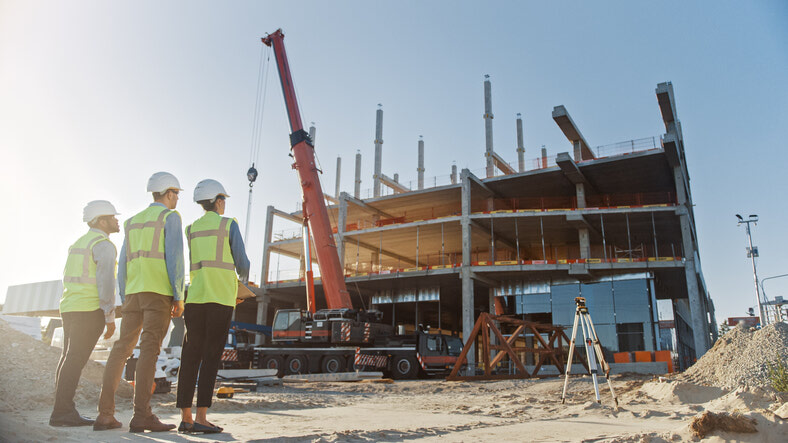Article Overview:
The article explains what a construction site survey is and why it represents the first critical step toward building with accuracy and confidence. It outlines the phases of a survey, from boundary and topographic mapping to layout staking, as-built verification, and QA/QC reporting, showing how each stage contributes to risk reduction and quality assurance. Readers will learn how modern land surveying equipment such as UAVs, GNSS receivers, and 3D laser scanners improves speed, precision, and data integration. The article highlights how verified survey data supports permitting, design alignment, and construction oversight, giving project managers the reliable information needed to keep builds efficient, compliant, and on schedule.
Every commercial project begins long before the first machine arrives on site. Success depends on knowing the precise boundaries, elevations, and conditions of the land you intend to build on. If you have ever asked what is a construction site survey or what is surveying in construction, the answer is simple: it is the process that turns design intent into a field-ready plan. A construction site survey gives project managers the data they need to build with confidence, reducing risks and ensuring accuracy from day one.
What Is Surveying in Construction?
Surveying in construction is the science and practice of measuring and mapping land so that every element of a project aligns with the approved design. Licensed surveyors use advanced instruments, GPS positioning, UAV mapping, and 3D scanning to create accurate reference points on the ground. These points guide excavation, foundation placement, and structural alignment, ensuring the physical build matches engineering specifications.
Without this process, even the most detailed design remains theoretical. Surveying transforms drawings into actionable data, reducing the chance of rework, disputes, or compliance failures. For project managers, it is the foundation of risk management and schedule control.
The Phases of a Construction Site Survey
A construction site survey unfolds in several distinct phases, each designed to capture specific information for planning and execution. The first phase typically involves a boundary and topographic survey, which establishes property lines and maps elevations, drainage patterns, and existing features. This data is critical for site planning and permitting, providing engineers and municipalities with verified conditions before work begins.
The next phase involves staking and layout, where surveyors physically mark control points for excavation, utilities, and foundations. These points translate design intent into exact ground positions. Finally, surveyors return for quality assurance checks and as-built surveys, confirming that construction has been executed according to plan. Each phase builds on the last, creating a clear, defensible record of accuracy.
Core Deliverables from a Construction Site Survey
Surveyors provide project managers with several key deliverables that directly influence planning, coordination, and execution on site. These deliverables are more than just documents, they are the foundation of accurate, defensible construction data.
Boundary and topographic maps establish the legal property lines and capture the existing surface conditions of the site, including elevations, drainage, and natural features. This information is critical for permitting, site planning, and risk management. Staked control points then translate these maps into physical markers, guiding excavation crews, utility installers, and structural teams to position work exactly as intended in the design.
Cut-and-fill calculations provide accurate quantities for earthwork and grading, ensuring contractors move the right volumes of material and stay within budgeted resources. As construction progresses, as-built surveys are conducted to verify that completed work matches design specifications and regulatory requirements. These checks prevent disputes, reduce the risk of rework, and ensure that construction aligns with approvals.
Finally, QA/QC reports document progress and accuracy in a clear, verifiable format. These reports become part of the project’s permanent record, supporting turnover packages for owners and regulators. Together, these deliverables give site teams the clarity they need to proceed without hesitation, keeping every trade aligned and every phase of the project accountable.
The Role of Technology in Modern Site Surveys
Modern surveying depends on advanced technology that improves both speed and accuracy. UAVs can capture aerial imagery and map large sites in hours rather than days, while 3D laser scanners create detailed digital models that support clash detection and quality control. Total stations and GNSS receivers provide millimeter-level precision for layout, ensuring that construction crews work from reliable data.
For project managers, this means survey results are not only faster to obtain but also easier to integrate into digital workflows. Real-time deliverables reduce uncertainty and provide clear insights into site conditions, enabling better planning and more confident decision-making.
Why Construction Site Surveys Are Critical for Project Accuracy
Accuracy is one of the most important drivers of commercial construction success. A misplaced boundary, miscalculated elevation, or missing setback can result in costly delays, compliance failures, or disputes. A construction site survey eliminates these risks by establishing verified data that can be trusted throughout the build.
This process also ensures accountability. Survey documentation satisfies permitting requirements, supports owner and regulator oversight, and provides a permanent record of site conditions. For project managers, this documentation is as valuable as the layout itself. It ensures the project stands up to scrutiny both during and after construction.
Building with Confidence Starts with a Site Survey
To answer the question what is surveying: it is the first and most critical step in making sure what you build matches what was designed. A construction site survey provides the data, layout, and verification needed to reduce risk, support compliance, and keep projects on track. From topographic mapping to staking and QA reporting, surveyors deliver field-ready information that allows project managers to build with confidence.
If you are preparing a commercial or industrial project, Apex Geomatics Construction Surveyors Ltd. provides accurate, defensible survey services that support your success from the ground up. Contact Apex Geomatics to partner with a team that ensures your next development begins with verified boundaries, field-ready layout, and precision you can build on.


